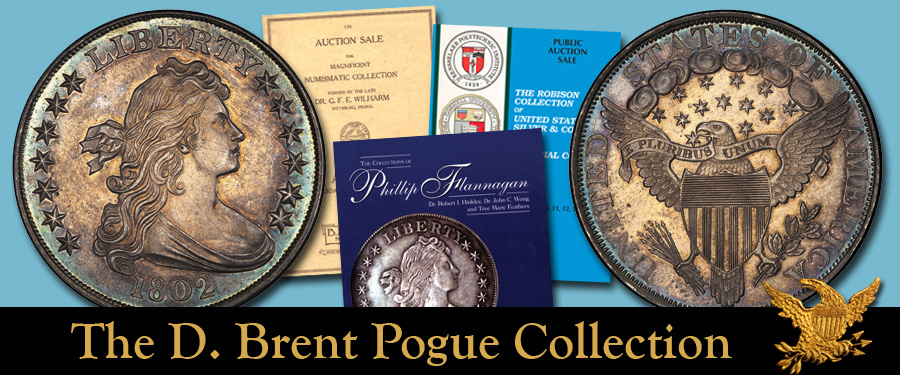
It is not often that we offer
a Proof “restrike” Draped Bust dollar. When we do, as with the D. Brent Pogue
Collection coin coming up for sale on March 31, it is a special occasion.
This silver dollar
combines rarity and beauty. When we auctioned it in 2001 we described it as:
“A splendid coin, a
challenge to the gem category, exquisitely struck and detailed in all areas,
and beautiful to the eye. The fields are toned light gold and champagne at the
center, changing to electric blue at the borders. Indeed, this is a true work
of numismatic art — breathtaking to contemplate, this in addition to its
rarity and other aspects of desirability.”
It is hard to imagine
that 2001, a pivotal year in American history, was 16 years ago. In some ways
it seems like only yesterday.
This coin, as is the case
with most Pogue Collection treasures, has been off the market for many years.
As such it will be fresh to the market for most potential bidders.
The mintage of the 1802
restrike dollars was not recorded, but was probably fewer than 10 coins. An estimated
five or six exist today. These are so rare (even when compared to the 1804
dollars) that often a period of years will elapse between our auction
offerings. For a specialized collection of early-dated dollars to have even one
of the three restrikes is a badge of accomplishment.
This and the related
Proof dollars of 1801 and 1803 are best called novodels — a term in Russian
numismatics for later productions of earlier-dated coins that never existed in
the first place. Although many 1802 circulation strike dollars were made, there
were no Proofs made at the time. The reverse die employed for the Proofs dated
1801, 1802, and 1803 was made in 1834 and was also employed on the famous 1804
Class I dollars, a curious situation as the single Class II and the six Class
III dollars are all from a different die.
The obverse dies for the
1802 and 1803 restrikes were probably made in the 1870s, by which time Class II
and III dollars were already known. The 1801 restrike seems to have been made
slightly later than the other two. The die for the 1801 was made from different
star, letter, and numeral punches. As explained in detail by Dave Bowers in United
States Silver Dollars and Trade Dollars: A Complete Encyclopedia, 1993, the
coins were struck in this order: 1804 Class I dollars, 1804 Class II and III
dollars, 1802 Proof restrikes, 1803 Proof restrikes, and 1801 Proof restrikes.
Here is the provenance of
this coin from our catalog: Dr.
G.F.E. Wilharm Collection; B. Max Mehl’s sale of the Dr. G.F.E. Wilharm Collection,
February 1921, lot 592; William Forrester Dunham Collection; B. Max Mehl’s sale
of the William Forrester Dunham Collection, June 1941, lot 1055; Abe Kosoff;
Michael F. Higgy Collection, by sale, August 1942; Numismatic Gallery (Abe
Kosoff); Numismatic Gallery’s (Abe Kosoff) sale of the Michael F. Higgy
Collection, September 1943, lot 817; Beverly Hills Stamp & Coin Co. (Max L.
Justus), August 1957 fixed price list; Newport Balboa Savings and Loan, by
sale, via Abe Kosoff and Ken Nichols; Stack’s sale of September 1978, lot 304;
Ellis Robison Collection; Doris and Ellis Robison; Rennselaer Polytechnic
Institute, Cornell University, Brown University, and Russell Sage College, by
gift, 1981; Stack’s sale of the Robison Collection, February 1982, lot 1884; Superior
Galleries’ session of Auction ’84, July 1984, lot 171; Bowers and Merena’s sale
of the Harry Einstein Collection, June 1986, lot 1734; Bowers and Merena’s sale
of the Collections of Phillip Flannagan, Dr. Robert I. Hinkley, Dr. John C.
Wong and Tree Many Feathers, November 2001, lot 4297.
My gosh, this coin is a
familiar friend! How nice to see it once again!





